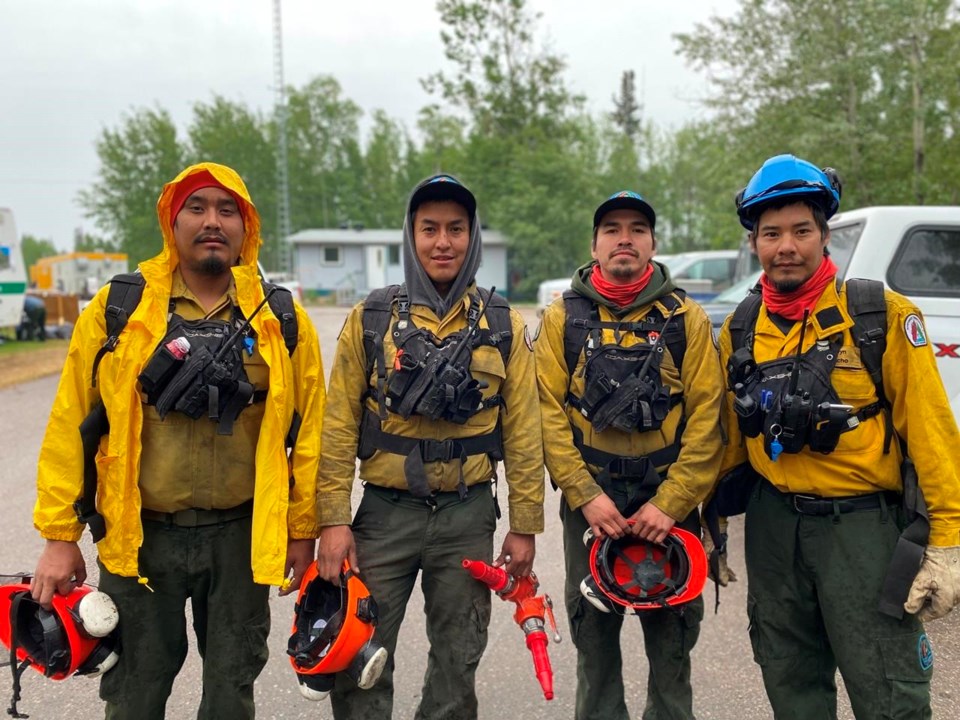HAY RIVER, N.W.T. — Residents of the town of Hay River are to be allowed to return to the Northwest Territories community Thursday, even as a wildfire continues to burn on the nearby K'atl'odeeche First Nation reserve.
About 3,500 residents from the town and reserve were forced to leave their homes on May 14.
A post on the town's Facebook page Wednesday said the evacuation order would be reduced to an evacuation alert, meaning residents are allowed to return but should be prepared to leave again if conditions worsen.
"Conditions are still not without risk, but the town recognizes the offsetting impact and risks to residents being away from their homes," the post states.
"The mayor and council appreciate residents’ sacrifices during this time. Countless people have relentlessly worked to ensure there has been no damage to your homes or properties and are excited for you to return."
Germaine Michel said she's looking forward to returning home. She has been staying in Manning, Alta., about 500 kilometres to the south, with friends after leaving Hay River in her camper in the middle of the night.
"The fire was bad. Really, really bad. It was across the river and you could see it," she said, adding it was smoky when she left.
"I don't think I really brought everything I needed. I just panicked and went around the house, got what I thought I needed and then left."
When she returns home, Michel said she plans to repack the camper in case they have to leave again.
Kate Latour said she's also happy to be able to go home. She, her husband and child have been staying at her brother's home in Fort Resolution, N.W.T.
"Hearing the evacuation alarm going off this year caused even more stress than I was imagining it might, and panic," she said.
Latour said she is grateful for the work of firefighters and other service providers. She said she and her family will be there to help K'atl'odeeche First Nation, which has suffered damage from the fire.
Glenn Smith, Hay River's senior administrative officer, said Tuesday during an overview of the re-entry plan that getting the fire under control was a key condition for allowing people to return. He said the fire will be active throughout the summer and weather will affect its severity and the risk it poses.
"We know that everyone wants to come home. We know that this has been extremely stressful on so many levels and we are doing everything we can to get you back home as soon as it is safe," Mayor Kandis Jameson said. "We had a safe evacuation and we are not going to risk bringing people back too soon."
Re-entry begins with the restoration of essential services on Wednesday, which includes calling in staff, completing inspections and assessments and stocking supplies. That is to be followed by general community re-entry on Thursday at noon, and finally allowing the return of people with special health-care needs, such as dialysis, once the evacuation alert is lifted.
The K'atl'odeeche First Nation will have a separate plan for residents to return.
Crews continue to tackle the out-of-control wildfire near the town that is more than 32 square kilometres in size. Firefighters are completing control lines to the south and east of the fire, and blacklining or extinguishing burnable fuels in front of control lines.
More than a dozen buildings have been damaged by the fire on the reserve.
While there have been spot fires in Hay River as winds carried embers over the river, there were no fires in the town Wednesday morning and no damage has been reported.
Residents from both K'atl'odeeche First Nation and Hay River were previously forced to leave their homes last May due to historic flooding in the area. In October, the Northwest Territories government said it estimated the flooding caused more than $174 million in damage to homes, businesses and infrastructure in the communities.
As of Wednesday, 11 fires were burning across the territory, including a nearly 57-square-kilometre fire about 50 kilometres south of Sambaa K'e. Crews have been pulled off that fire due to its intensity and risk but it is still being monitored.
A wildfire greater than 38 square kilometres in size is also burning around 100 kilometres west of Kakisa. The territory said the community is not at risk.
A total of 17 wildfires have burned around 170 square kilometres in the territory this season so far.
This report by The Canadian Press was first published May 24, 2023.
— By Emily Blake in Yellowknife.
This story was produced with the financial assistance of the Meta and Canadian Press News Fellowship.
The Canadian Press




